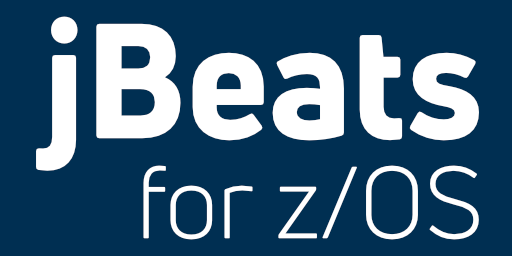jBeats for z/OS

Discover the easy way to use your mainframe data with Elasticsearch!
Unlock the full potential of your z/OS data with the possibilities of Elasticsearch!
With jBeats4zOS from Next Stride you can merge the two wolds in a simple fashion!
jBeats4zOS – Elasticsearch Extension for z/OS
End-to-End-Monitoring
The IT infrastructures of today are getting increasingly more complex. While the decentralized world has developed its methods and procedures to bring the increasing number of systems and sources of log data under control, mainframe systems are often poorly integrated with end-to-end monitoring.
jBeats closes this gap by providing you with a tool that lets you integrate the log files into the central log management.
Lack of higher-level visibility and search capability
Often, a superordinate view of all systems involved in a service is required, which should also be flexibly searchable and suitable for management.
In many cases, however, the tools used are more like monitors that can be used to track current system statuses. These are well suited for insights into individual system areas, but concentrate on their actual task.
In most cases, there is a lack of options for graphical processing and the display of historical time series. The monitors also generate log data that could be used beneficially if they could be evaluated.
In addition, searching heterogeneous databases is often difficult if the formats are not harmonized at a central location.
jBeats Factsheet - in a nutshell
#benefitwithjbeats
With jBeats you get more out of your z/OS data!
More end-to-end visibility in heterogeneous environments
With jBeats for z/OS, you have access to all the data sources you need for a comprehensive end-to-end view of your services…
Learn more ->
More capacity and performance management in real time
In many companies, IT is now one of, if not the central production factor…
Learn more ->
More through centralized logging with Elasticsearch
In recent years, Elasticsearch has become the defacto standard in centralized log management…
Learn more ->
#whatjbeatscando
What can jBeats4zOS do for you?
Wondering what added value jBeats4zOS – Elasticsearch Extension for z/OS can provide you? We believe that there is a lot to say about this!
The listing below is a nonexhaustive list of data sources that are already available for jBeats today and provide real value to our customers.
Thomas Feldmann, CEO Next Stride AG

In our company, we have what feels like an eternity of experience in the mainframe environment. We know the problems that users have to deal with every day.
This knowledge gave birth to the idea of using the best of both worlds to offer our customers real value by giving them time to focus on the essentials again.
More than 50 available data types
As of today, jBeats4zOS already supports more than 50 parsers for SMF. Among others, System (SMF70), TASK (SMF 30) and WLM (SMF 72) can be processed and made available directly in Elasticsearch.
The exhaustive list of supported data types can be found here.
Log data
Parsers are available for application and system logs. With the help of GROK-Parsers you can make unstructured text-based logs usable for yourself. There are predefined patterns that can be used to parse Websphere application server access logs, for example.
JSON and XML parsers are available for structured data sources.
z/OS Syslog
The z/OS syslog is the central source of information for operating, system monitoring and alerting. The contents are used as a source of information for problem analysis.
zBeats4zOS enables a cross-sysplex full text search of your syslog data!
IMS
With IMS, many companies have a powerful transaction monitor at their disposal. With zBeats4zOS you monitor your critical applications in terms of response times, timeouts and error codes! IMS-Log and IMF are supported as data sources!
CICS
With zBeats4zOS you monitor your critical applications in terms of response times, timeouts and error codes directly from the CICS records!
DB2
Identify and optimize long-running database queries with jBeats4zOS. This saves resources, money and improves response times for your customers!
Monitor buffer pools, execution plans and connections of your database systems.
TCP/IP
Monitor mainframe network activities with jBeats4zOS. This includes connections, FTP and throughput.
Security Reporting
Create reports on who accessed and modified which datasets at which point in time. Track the lifecycle of your data.
In conjunction with your access profiles, compliance reporting can be easily mapped.
DCollect
With the data from DCollect, you can view DataSet statistics. For example, you can check the utilization of your disk and storage pools or find out when which datasets were created and how large they are.
Even the question of which datasets have been backed up can be answered.
RMF in real time
With jBeats4zOS, metrics and reports can be read directly from the RMF Distributed Data Server (RMF-DDS) using https calls. This allows dashboards to be created in Kibana, for example on the current system load.
MQ
MQ, also known as “WebSphere MQ”, is a message bus and enables the communication of programs over a network of different hardware and software components.
With jBeats, you can also bring transparency into this area.
#howjbeatsworks
How does jBeats4zOS – Elasticsearch Extension for z/OS work?
z/OS Data Collection
The z/OS Data Collector from Beats is started as a dedicated Started Task in the z/OS…
Learn more ->
Integration as Beats in Kibana
jBeats for zOS ist fully integrated into the Elastic Stack…
Learn more ->
Support for z/OS System Logger
With the System Logger there is a powerful MVS component available…
Learn more ->
Configuration
Beats for z/OS also offers you full flexibility in the configuration of the source data…
Learn more ->
#whyjbeats
Why jBeats from Next Stride?
15 years of Experience
For 15 years we have been producing parsers to make the sometimes very complex log files usable for reports and analyses. We open up new data sets on request and adapt them if there should be changes.
By the way, third-party software is not required to use the parsers!
The parsers in jBeats are also used in our software suite JANE, which has been used by renowned companies for many years.
These companies also trust our expertise because the correctness of the data has been successfully proven in many projects!
Precalculated Metrics
Data from z/OS log files alone often has only limited significance in its raw format.
They only become valuable when they are meaningfully combined and calculated into relevant key figures.
As an example, system utilization data (SMF70) must be converted to IBM or Gartner MIPS or converted from hardware to software MSU.
jBeats does the work of merging and calculating for you and simultaneously provides many relevant metrics. This gives you direct information that you can really use in your daily work.
Quality first!
Quality creates trust. With jBeats, you are also on the safe side here. The data we provide is checked for plausibility and correctness in a continuous process. This gives you the security that you can rely on the basis of your analyses!
The integrated “Duplicate Checking” also creates quality. This feature recognizes and ignores data that has already been processed unchanged. For this purpose, each data record is provided with a unique key and checked to see whether it has already been processed once.
In this way, any data gaps that may occur can be closed without the risk of multiple processing.

